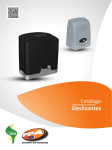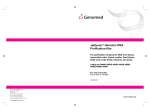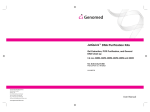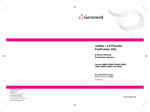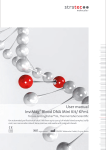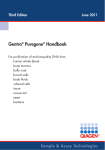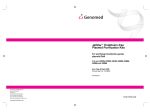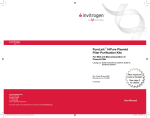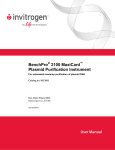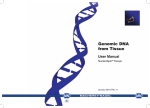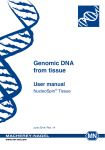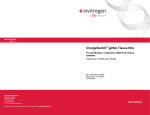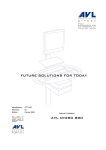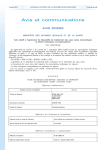Download JETFLEX Genomic DNA Manual
Transcript
Genomed JetFlex Genomic DNA Purification Kits For fast and reliable purification of genomic DNA from blood, mammalian cells, tissue, buffy coat, and all types of body fluids Cat. nos. 600100 and 600500 Rev. Date: 12 Aug 2010 Manual part no.: 70-15019 MAN0001744 Corporate Headquarters Genomed GmbH Poststr. 22 D-32584 Löhne, Germany Tel:+49-(0)5732-904700 Fax:+49-(0)5732-9047010 [email protected] www.genomed-dna.com User Manual ii Table of Contents Kit Contents and Storage ..................................................................iv Introduction......................................................................1 System Overview................................................................................ 1 Experimental Outline ......................................................................... 3 Methods ............................................................................4 General Information ........................................................................... 4 Purifying gDNA from Blood............................................................. 6 Purifying gDNA from Mammalian Cells ...................................... 11 Purifying gDNA from Tissues ........................................................ 15 Purifying gDNA from Body Fluids................................................ 18 Purifying gDNA from Swabs.......................................................... 23 Purifying gDNA from Bacteria ....................................................... 27 Purifying gDNA from Yeast............................................................ 31 Estimating DNA Yield ..................................................................... 35 Troubleshooting................................................................................ 36 Appendix ........................................................................38 Procedure for Pellet Compacting ................................................... 38 Purifying Impure DNA.................................................................... 39 Accessory Products .......................................................................... 40 Technical Support............................................................................. 41 Purchaser Notification ..................................................................... 42 iii Kit Contents and Storage Types of Kits This manual is supplied with the following products. Product Quantity Cat. no. JetFlex Genomic DNA Purification Kit 100 600 100 500 600 500 Intended Use For research use only. Not intended for human or animal diagnostic or therapeutic uses. Shipping and Storage Each kit is shipped at room temperature. Upon receipt, store all buffers at room temperature and store all enzymes at 4°C. Note: For long-term storage, aliquot RNase A in single use tubes and store at −20ºC. All components are guaranteed stable for 6 months when stored properly. Continued on next page iv Kit Contents and Storage, Continued Kit Contents The components included in the JetFlex genomic DNA (gDNA) Purification Kits are listed below. Reagents 100 preps 500 preps 600 100 600 500 Red Blood Cell Lysis Buffer (RBC) 33 mL 165 mL Cell Lysis Buffer (CLB) 33 mL 165 mL Protein Precipitation Buffer (PPT) 17 mL 83 mL Pellet Compactor 8 mL 30 mL DNA Dissolving Buffer (TE) 22 mL 110 mL 2 × 21 mg 10 × 21 mg 1 mL 5 × 1 mL Proteinase K (lyophilized powder) RNase A (4 mg/mL) Sufficient reagents are included in the kit for 100 or 500 preparations. For larger starting sample volumes, the number of preparations will be decreased and for smaller starting sample volumes, the number of preparations per kit will be increased. Continued on next page v Kit Contents and Storage, Continued Buffer Composition The composition of buffers included in the JetFlex gDNA Kits is listed below. Buffer vi Composition Red Blood Cell Lysis Buffer Proprietary Formulation Cell Lysis Buffer Proprietary Formulation Protein Precipitation Buffer Proprietary Formulation Pellet Compactor Proprietary Formulation DNA Dissolving Buffer (TE) 10 mM Tris-HCl, 0.1 mM EDTA, pH 8.5 Proteinase K Lyophilized powder RNase A 4 mg/mL in 50 mM TrisHCl, 10 mM EDTA, pH 8.0 Introduction System Overview Introduction The JetFlex Genomic DNA Purification Kits allow for the rapid and efficient purification of high quality, high molecular weight, RNA-free genomic DNA (gDNA). The kits are designed to efficiently isolate genomic DNA from mammalian cells and tissues, blood samples, plant tissue, bacteria, and yeast in a single tube without the use of spin columns or a vacuum manifold. The procedure is readily scaled up or down, making it adaptable for a wide variety of starting sample volumes. DNA up to 150 kb in size may be purified. System Summary Genomic DNA is purified with the JetFlex gDNA Purification Kits by lysing nuclei with a cell lysis buffer and if necessary, treating the sample with RNase A and Proteinase K to degrade RNA and proteins. DNA is then precipitated under high salt conditions to remove impurities. Following ethanol removal, the DNA is redissolved in the DNA Dissolving Buffer (TE). Advantages The advantages of using JetFlex Genomic DNA Purification Kits are: • Efficient purification of genomic DNA up to 150 kb from a variety of samples such as mammalian cells and tissues, blood samples, body fluids, plant tissue, bacteria, and yeast • Rapid purification of high-quality DNA within 30 minutes without using any organic or toxic reagents • Minimal contamination from RNA • Reliable performance of the purified DNA in PCR, restriction enzyme digestion, and Southern blotting Continued on next page 1 System Overview, Continued Sample treatment and DNA Yield Species & Material The table below lists the expected yield and necessary sample treatment according to the starting material. Typical DNA yield Human Whole Blood • 300 μL • 5–10 μg • 2 mL • 50–100 μg • 10 mL • 250–500 μg • 50 mL • 1.25–2.5 mg Proteinase K treatment RNase A treatment Page no. Optional Optional 6 Non-Mammalian Blood 2.5–7.5 mg/mL Optional Required 6 Cultured Cells 10–30 μg per 3 × 106 cells Optional Required 11 Animal Tissue 20–150 μg per 10 mg Required Required 15 Plant Tissue 10–15 μg per 40 mg Required Required 15 Body Fluids 2–50 μg/mL Optional Optional 18 Swabs (Buccal, Pharyngeal, Nasal, Vaginal, etc.) 0.5–3.5 μg Optional Optional 23 Gram-Negative Bacteria 20 μg/mL of culture Optional Required 27 Gram-Positive Bacteria 10 μg/mL of culture Optional Required 27 Yeast 5–7 μg/mL No Required 31 2 Experimental Outline Introduction The figure below illustrates the basic steps necessary to use the kit. Collect sample and pretreat as directed for blood, swabs, tissue, bacteria, and yeast Optional: Treat sample with Proteinase K and RNase A Add an equal volume of isopropanol to the supernatent Wash DNA pellet with 1 mL 70% Ethanol Air dry the pellet and resuspend with DNA Dissolving Buffer (TE) 3 Methods MEND ION AT RECOM General Information Safety Information Follow the recommendations below to obtain the best results: • Maintain a sterile environment when handling DNA to avoid any contamination from DNases and ensure that no DNases are introduced into the sterile solutions of the kit • Make sure all equipment that comes in contact with DNA is sterile, including pipette tips and microcentrifuge tubes • To minimize DNA degradation, perform lysate preparation steps quickly, and avoid repeated freezing and thawing of DNA samples • Perform all centrifugation steps at room temperature • Incubate sample overnight with DNA Dissolving Buffer Follow the safety guidelines below when using the kit. • Treat all reagents supplied in the kit as potential irritants. • Wear a suitable lab coat, disposable gloves, and goggles. • Handle all blood and tissue samples in compliance with established institutional guidelines and take the appropriate precautions (wear a laboratory coat, disposable gloves, and eye protection). Since safety requirements for use and handling of blood and tissue samples may vary at individual institutions, consult the health and safety guidelines and/or officers at your institution. • When processing blood and tissue samples, dispose of the waste appropriately as biohazardous waste. Continued on next page 4 General Information, Continued Before Starting Resuspend Proteinase K in double-distilled or Milli-Q®grade water to a final concentration of 20 mg/mL. Store the reconstituted enzyme in single-use aliquots at −20ºC. Avoid repeated freezing and thawing. Milli-Q ® is a registered trademark of Millipore Corporation 5 Purifying gDNA from Blood Starting Sample JetFlex Genomic DNA Purification Kits are designed to purify genomic DNA from fresh or frozen whole blood, or buffy coat samples which may be collected in the presence of anti-coagulants such as EDTA, heparin, or citrate. Since EDTA also reduces DNA degradation, EDTA is the optimal anti-coagulant. To obtain high-quality genomic DNA, follow the guidelines recommended on page 4. Materials Needed • Sample for DNA isolation • Sterile, DNase-free microcentrifuge tubes (for small preparations) or sterile, DNase-free 15 mL or 50 mL tubes (for larger sample preparation) • Vortex mixer (multi-tube vortexer recommended) • Water baths or heat blocks • Centrifuge capable of centrifuging >12,000 × g • Isopropanol • 70% ethanol Components supplied with the kit • Red Blood Cell Lysis Buffer (RBC) • Cell Lysis Buffer (CLB) • Proteinase K (lyophilized powder, see Before Starting, page 5) • RNase A (4 mg/mL) • Protein Precipitation Buffer (PPT) • DNA Dissolving Buffer (TE) Continued on next page 6 Purifying gDNA from Blood, Continued Preparing Blood Lysate Prepare lysate from blood samples as described below. 1. 2. Add fresh or frozen blood or buffy coat to an equal volume of RBC Lysis Buffer. Common starting volumes are shown in the table below. Starting Sample Vol. RBC Lysis Buffer Vol. 300 μL 300 μL 2 mL 2 mL 10 mL 10 mL 50 mL 50 mL Mix well by inverting the tube until the mixture is homogenous. Note: If the blood sample is fresh (drawn within 1 hour), incubate at room temperature for one minute to ensure complete lysis of erythrocytes. 3. Centrifuge the sample according to the conditions in the table. Starting Sample Vol. 300 μL Starting Sample Vol. > 2 mL Acceleration 12,000 × g 2,000 × g Time 30 seconds 10 minutes Centrifugation Conditions 4. Remove the red supernatant, leaving behind a pellet of DNA-containing white blood cells. Bump vortex the white cell pellet vigorously to loosen the cells from the wall, which enhances cell lysis (next step). Continued on next page 7 Purifying gDNA from Blood, Continued Preparing Blood Lysate, Continued 5. Add an equal volume of Cell Lysis Buffer (CLB) to the disrupted cell pellet (i.e., for a 300 μL starting sample, add 300 μL CLB). Lyse the cells by pipetting up and down. Note: Usually no incubation is required. However, if cell clumps are visible after mixing, incubate at 37°C or room temperature until the lysate is homogeneous and clear. Samples are stable in CLB for several months at room temperature. 6. Optional: For every 300 μL starting sample volume, add 20 μL Proteinase K. Incubate at 58ºC for 1 hour to overnight until the mixture is clear, indicating complete lysis. Note: The optional Proteinase K digestion is necessary if the blood sample is partially or completely clotted. 7. Optional: For every 300 μL starting sample volume, add 1.5 μL RNase A (i.e., add 1 μL RNase A to a 200 μL starting sample). Incubate at 37ºC for 5 minutes. 8. Allow the lysate to cool to room temperature and then proceed directly to Purifying gDNA, next page. Continued on next page 8 Purifying gDNA from Blood, Continued Purifying gDNA The following procedure is for purifying DNA from 300 μL blood lysate. To purify DNA from different starting sample volumes, scale up or down the buffer and reagent volumes proportionately. 1. Add 150 μL Protein Precipitation Buffer (PPT) to 300 μL of blood lysate from Step 8, previous page. 2. Mix thoroughly by vortexing for 20 seconds until a homogenous suspension is obtained. 3. Centrifuge at 12,000 × g for 3 minutes at room temperature. Note: The precipitated proteins form a compact pellet and the supernatant should be clear. If the protein pellet is loose or insignificant, proceed to Procedure for Pellet Compacting, page 38. 4. Transfer the supernatant into a clean, sterile microcentrifuge tube. 5. Add an equal volume of isopropanol. Mix thoroughly by inverting the tube until the mixture is homogenous. Do not vortex. 6. Centrifuge at 12,000 × g for 3 minutes at room temperature. Note: The precipitated DNA is visible as a white pellet. 7. Decant the supernatant. Allow residual liquid to drain on a sheet of absorbent paper towel for a few minutes. 8. Add 1 mL 70% ethanol and wash the DNA pellet by inverting the tube several times. 9. Centrifuge at 12,000 × g for 1 minute at room temperature. 10. Carefully decant the supernatant. Note: Be careful not to discard the DNA as the DNA pellet may be loosely adherent to the tube. 11. Allow residual liquid to drain on a sheet of absorbent paper towel for a few minutes. Continued on next page 9 Purifying gDNA from Blood, Continued Purifying gDNA, Continued 12. Evaporate residual ethanol by incubating the sample at 50 ºC to 55ºC for 10 minutes. Note: If desired, you may evaporate residual ethanol at room temperature, but in this case, increase the incubation time. 13. After ethanol evaporation is complete (i.e., DNA pellet appears dry and the ethanol odor is undetectable), resuspend the DNA pellet in a suitable volume of DNA Dissolving Buffer (TE). 14. Incubate the tube at room temperature overnight or at 65ºC for up to one hour to completely resuspend the DNA. The DNA should be completely dissolved as a clear, colorless solution. If precipitates are present, the A260/A280 ratio is <1.70, or the DNA is contaminated with buffer, protein, or RNA, re-purify the DNA sample (see Purifying Impure DNA, page 39). Storing DNA 10 To avoid repeated freezing and thawing of DNA, • Store the purified DNA at 4°C for immediate use or • Aliquot the DNA and store at −20°C for long-term storage. Purifying gDNA from Mammalian Cells Introduction The JetFlex Genomic DNA Purification Kits are designed to purify genomic DNA from 1–2 × 106 to 1–2 × 107 mammalian cells. To obtain high-quality genomic DNA, follow the guidelines recommended on page 4. Materials Needed • Sample for DNA isolation • Phosphate Buffered Saline (PBS), see page 40 for ordering information • Sterile, DNase-free microcentrifuge tubes (for small preparations) or sterile, DNase-free 15 mL or 50 mL tubes (for larger sample preparation) • Vortex mixer (multi-tube vortexer recommended) • Water baths or heat blocks • Centrifuge capable of centrifuging >12,000 × g • Isopropanol • 70% ethanol Components supplied with the kit • Cell Lysis Buffer (CLB) • Proteinase K (lyophilized powder, see Before Starting, page 5) • RNase A (4 mg/mL) • Protein Precipitation Buffer (PPT) • DNA Dissolving Buffer (TE) Continued on next page 11 Purifying gDNA from Mammalian Cells, Continued Preparing Cell Lysate Place cells on ice immediately before processing. 1. Collect 1–2 × 106 to 1–2 × 107 cells in a balanced salt solution (i.e., PBS). 2. Centrifuge the cells according the conditions in the table. Centrifugation Conditions Starting Sample 1–2 × 106 cells Starting Sample 1–2 × 107 cells Acceleration 12,000 × g 2,000 × g Time 15 seconds 2 minutes 3. Remove the supernatant. 4. Add Cell Lysis Buffer (CLB) to the disrupted cell pellet. Starting Cell Count 300 μL 7 3 mL 1–2 × 10 1–2 × 10 5. Buffer CLB 6 Lyse the cells by pipetting up and down. Note: Usually no incubation is required. However, if cell clumps are visible after mixing, incubate at 58°C until the lysate is homogeneous and clear. Samples are stable in CLB for several months at room temperature. 6. Optional: Add Proteinase K (20 mg/mL). Incubate at 58ºC for 1 hour to overnight until the mixture is clear, indicating complete lysis. Starting Cell Count Proteinase K 6 20 μL 7 200 μL 1–2 × 10 1–2 × 10 Continued on next page 12 Purifying gDNA from Mammalian Cells, Continued Preparing Cell Lysate, Continued 7. Add RNase A. Incubate at 37ºC for 5 minutes. Starting Cell Count 10 μL 7 100 μL 1–2 × 10 1–2 × 10 8. Purifying gDNA RNase A 6 Allow the lysate to cool to room temperature and then proceed directly to Purifying gDNA, below. The following procedure is for purifying DNA from 300 μL cellular lysate. To purify DNA from a different starting sample volume, scale up or down the buffer and reagent volumes proportionately. 1. Add 150 μL Protein Precipitation Buffer (PPT) to 300 μL of cellular lysate from Step 8, above. 2. Mix thoroughly by vortexing for 20 seconds until a homogenous suspension is obtained. 3. Centrifuge at 12,000 × g for 3 minutes at room temperature. Note: The precipitated proteins form a compact pellet and the supernatant should be clear. If the protein pellet is loose or insignificant, proceed to Procedure for Pellet Compacting, page 38. 4. Transfer the supernatant into a clean, sterile microcentrifuge tube. 5. Add an equal volume of isopropanol. Mix thoroughly by inverting the tube until the mixture is homogenous. Do not vortex. 6. Centrifuge at 12,000 × g for 3 minutes at room temperature. Note: The precipitated DNA is visible as a white pellet. Continued on next page 13 Purifying gDNA from Mammalian Cells, Continued Purifying gDNA, Continued 7. Decant the supernatant. Allow residual liquid to drain on a sheet of absorbent paper towel for a few minutes. 8. Add 1 mL 70% ethanol and wash the DNA pellet by inverting the tube several times. 9. Centrifuge at 12,000 × g for 1 minute at room temperature. 10. Carefully decant the supernatant. Note: Be careful not to discard the DNA as the DNA pellet may be loosely adherent to the tube. 11. Allow residual liquid to drain on a sheet of absorbent paper towel for a few minutes. 12. Evaporate residual ethanol by incubating the sample at 50 ºC to 55ºC for 10 minutes. Note: If desired, you may evaporate residual ethanol at room temperature, but in this case, increase the incubation time. 13. After ethanol evaporation is complete (i.e., DNA pellet appears dry and the ethanol odor is undetectable), resuspend the DNA pellet in a suitable volume of DNA Dissolving Buffer (TE). 14. Incubate the tube at room temperature overnight or at 65ºC for up to one hour to completely resuspend the DNA. The DNA should be completely dissolved as a clear, colorless solution. If precipitates are present, the A260/A280 ratio is <1.70, or the DNA is contaminated with buffer, protein, or RNA, re-purify the DNA sample (see Purifying Impure DNA, page 39). Storing DNA 14 To avoid repeated freezing and thawing of DNA, • Store the purified DNA at 4°C for immediate use or • Aliquot the DNA and store at −20°C for long-term storage. Purifying gDNA from Tissues Introduction The JetFlex Genomic DNA Purification Kits are designed to purify genomic DNA from fresh, frozen, fixed, or paraffinembedded animal (including mouse tail) and plant tissues. To obtain high-quality genomic DNA, follow the guidelines recommended on page 4. Materials Needed • Sample for DNA isolation • Sterile, DNase-free microcentrifuge tubes (for small preparations) or sterile, DNase-free 15 mL or 50 mL tubes (for larger sample preparation) • Vortex mixer (multi-tube vortexer recommended) • Water baths or heat blocks • Centrifuge capable of centrifuging >12,000 × g • Isopropanol • 70% ethanol Components supplied with the kit • Cell Lysis Buffer (CLB) • Proteinase K (lyophilized powder, see Before Starting, page 5) • RNase A (4 mg/mL) • Protein Precipitation Buffer (PPT) • DNA Dissolving Buffer (TE) Continued on next page 15 Purifying gDNA from Tissues, Continued Preparing Tissue Lysate The following procedure is for purifying DNA from up to 10 mg fresh, frozen, fixed, or paraffin-embedded tissue sample. To purify DNA from a larger tissue sample, scale up the buffer and reagent volumes proportionately. 1. Grind the tissue sample in liquid nitrogen with mortar and pestle. Keep the sample on ice to minimize DNase activity. 2. Add 300 μL Cell Lysis Buffer (CLB) to the tissue sample. Note: Optional: Homogenize the sample thoroughly using 30–50 strokes with a tube pestle. Purifying gDNA 3. Add 20 μL Proteinase K. Incubate at 58ºC for 1 hour to overnight until the mixture is clear, indicating complete lysis. 4. Add 10 μL RNase A. Incubate at 37ºC for 5 minutes. 5. Allow the lysate to cool to room temperature and then proceed directly to Purifying gDNA, below. 1. Add 150 μL Protein Precipitation Buffer (PPT) to 300 μL of tissue lysate from Step 5, above. 2. Mix thoroughly by vortexing for 20 seconds until a homogenous suspension is obtained. 3. Centrifuge at 12,000 × g for 3 minutes at room temperature. Note: The precipitated proteins form a compact pellet and the supernatant should be clear. If the protein pellet is loose or insignificant, proceed to Procedure for Pellet Compacting, page 38. 4. Transfer the supernatant into a clean, sterile microcentrifuge tube. 5. Add an equal volume of isopropanol. Mix thoroughly by inverting the tube until the mixture is homogenous. Do not vortex. Continued on next page 16 Purifying gDNA from Tissues, Continued Purifying gDNA, Continued 6. Centrifuge at 12,000 × g for 3 minutes at room temperature. Note: The precipitated DNA is visible as a white pellet. 7. Decant the supernatant. Allow residual liquid to drain on a sheet of absorbent paper towel for a few minutes. 8. Add 1 mL 70% ethanol and wash the DNA pellet by inverting the tube several times. 9. Centrifuge at 12,000 × g for 1 minute at room temperature. 10. Carefully decant the supernatant. Note: Be careful not to discard the DNA as the DNA pellet may be loosely adherent to the tube. 11. Allow residual liquid to drain on a sheet of absorbent paper towel for a few minutes. 12. Evaporate residual ethanol by incubating the sample at 50 ºC to 55ºC for 10 minutes. Note: If desired, you may evaporate residual ethanol at room temperature, but in this case, increase the incubation time. 13. After ethanol evaporation is complete (i.e., DNA pellet appears dry and the ethanol odor is undetectable), resuspend the DNA pellet in a suitable volume of DNA Dissolving Buffer (TE). 14. Incubate the tube at room temperature overnight or at 65ºC for up to one hour to completely resuspend the DNA. The DNA should be completely dissolved as a clear, colorless solution. If precipitates are present, the A260/A280 ratio is <1.70, or the DNA is contaminated with buffer, protein, or RNA, re-purify the DNA sample (see Purifying Impure DNA, page 39). Storing DNA To avoid repeated freezing and thawing of DNA, • Store the purified DNA at 4°C for immediate use or • Aliquot the DNA and store at −20°C for long-term storage. 17 Purifying gDNA from Body Fluids Introduction JetFlex Genomic DNA Purification Kits are designed to purify genomic DNA from body fluids such as plasma, saliva, serum, milk, urine, cerebrospinal fluid, and sputum. To obtain high-quality genomic DNA, follow the guidelines recommended on page 4. Materials Needed • Sample for DNA isolation • Sterile, DNase-free microcentrifuge tubes (for small preparations) or sterile, DNase-free 15 mL or 50 mL tubes (for larger sample preparation) • Vortex mixer (multi-tube vortexer recommended) • Water baths or heat blocks • Centrifuge capable of centrifuging >12,000 × g • Isopropanol • 70% ethanol Components supplied with the kit • Cell Lysis Buffer (CLB) • Proteinase K (lyophilized powder, see page 5) • RNase A (4 mg/mL) • Protein Precipitation Buffer (PPT) • DNA Dissolving Buffer (TE) Continued on next page 18 Purifying gDNA from Body Fluids, Continued Preparing Concentrated Lysates 1. If the body fluid sample is dilute or has few DNAcontaining cells, concentrate the cells by centrifugation according the conditions listed in the table below. Centrifugation Conditions Starting Sample Volume < 1.5 mL Starting Sample Volume > 1.5 mL Acceleration 12,000 × g 5,000 × g Time 30 seconds 2 minutes 2. 3. Following centrifugation, aspirate the supernatant and resuspend the cell pellet in PBS using the volumes listed in the table below. Starting Volume PBS < 1.5 mL 200 μL > 1.5 mL 3–10 mL Proceed directly to Preparing Body Fluid Lysate, next page. Continued on next page 19 Purifying gDNA from Body Fluids, Continued Preparing Body Fluid Lysate 1. Add 5 volumes of Cell Lysis Buffer (CLB) to 1 volume of body fluid (i.e., add 250 μL CLB to 50 μL body fluid). Lyse the cells immediately by pipetting up and down. Note: Samples may be fresh or frozen and may contain cellular debris. If the sample has a high protein content, increase the CLB ratio to 11:1 (i.e., 550 μL CLB for a 50 μL body fluid sample). 2. Incubate at 58°C until the lysate is homogeneous and clear. 3. Optional: Add 1 μL Proteinase K for every 2.5 μL of starting body fluid (i.e., add 20 μL Proteinase K to a 50 μL body fluid starting sample). 4. Incubate at 58ºC for 1 hour to overnight until the mixture is clear, indicating complete lysis. Note: If any cellular debris or particulate matter is still present after lysis, centrifuge the sample and transfer the clear supernatant to a clean tube. 5. Optional: Add 1 μL RNase A for every 5 μL starting sample volume, (i.e., add 10 μL RNase A to a 50 μL body fluid starting sample). Incubate at 37ºC for 5 minutes. 6. Allow the lysate to cool to room temperature and then proceed directly to Purifying gDNA, next page. Continued on next page 20 Purifying gDNA from Body Fluids, Continued Purifying gDNA The following procedure is for purifying DNA from 300 μL cellular lysate. To purify DNA from a different starting sample volume, scale up or down the buffer and reagent volumes proportionately. 1. Add 150 μL Protein Precipitation Buffer (PPT) to 300 μL of cellular lysate from Step 6, previous page. 2. Mix thoroughly by vortexing for 20 seconds until a homogenous suspension is obtained. 3. Centrifuge at 12,000 × g for 3 minutes at room temperature. Note: The precipitated proteins form a compact pellet and the supernatant should be clear. If the protein pellet is loose or insignificant, proceed to Procedure for Pellet Compacting, page 38. 4. Transfer the supernatant into a clean, sterile microcentrifuge tube. 5. Add an equal volume of isopropanol. Mix thoroughly by inverting the tube until the mixture is homogenous. Do not vortex. 6. Centrifuge at 12,000 × g for 3 minutes at room temperature. Note: The precipitated DNA is visible as a white pellet. 7. Decant the supernatant. Allow residual liquid to drain on a sheet of absorbent paper towel for a few minutes. 8. Add 1 mL 70% ethanol and wash the DNA pellet by inverting the tube several times. 9. Centrifuge at 12,000 × g for 1 minute at room temperature. 10. Carefully decant the supernatant. Note: Be careful not to discard the DNA as the DNA pellet may be loosely adherent to the tube. Continued on next page 21 Purifying gDNA from Body Fluids, Continued Purifying gDNA, Continued 11. Allow residual liquid to drain on a sheet of absorbent paper towel for a few minutes. 12. Evaporate residual ethanol by incubating the sample at 50 ºC to 55ºC for 10 minutes. Note: If desired, you may evaporate residual ethanol at room temperature, but in this case, increase the incubation time. 13. After ethanol evaporation is complete (i.e., DNA pellet appears dry and the ethanol odor is undetectable), resuspend the DNA pellet in a suitable volume of DNA Dissolving Buffer (TE). 14. Incubate the tube at room temperature overnight or at 65ºC for up to one hour to completely resuspend the DNA. The DNA should be completely dissolved as a clear, colorless solution. If precipitates are present, the A260/A280 ratio is <1.70, or the DNA is contaminated with buffer, protein, or RNA, re-purify the DNA sample (see Purifying Impure DNA, page 39). Storing DNA 22 To avoid repeated freezing and thawing of DNA, • Store the purified DNA at 4°C for immediate use or • Aliquot the DNA and store at −20°C for long-term storage. Purifying gDNA from Swabs Introduction The JetFlex Genomic DNA Purification Kits are designed to purify genomic DNA from swabs, including buccal, pharyngeal, nasal, and vaginal. To obtain high-quality genomic DNA, follow the guidelines recommended on page 4. Materials Needed • Sample for DNA isolation • Sterile, DNase-free microcentrifuge tubes (for small preparations) or sterile, DNase-free 15 mL or 50 mL tubes (for larger sample preparation) • Vortex mixer (multi-tube vortexer recommended) • Water baths or heat blocks • Centrifuge capable of centrifuging >12,000 × g • Isopropanol • 70% ethanol Components supplied with the kit • Cell Lysis Buffer (CLB) • Proteinase K (lyophilized powder, see Before Starting, page 5) • RNase A (4 mg/mL) • Protein Precipitation Buffer (PPT) • DNA Dissolving Buffer (TE) Continued on next page 23 Purifying gDNA from Swabs, Continued Preparing Swab Lysate 1. Collect the buccal swab with a suitable tool, such as a T-swab Kit, Dacron swab, C.E.P. Omni swab, or Cotton swab according to standard collection procedures. Nasal, pharyngeal, or vaginal swabs can be collected in a similar manner. 2. Set a water bath or heat block at 58°C. 3. Place the buccal swab into a capped 2 mL microcentrifuge tube (not provided with the kit). • For C.E.P. Omni swabs, press the stem end towards the swab to eject it into the microcentrifuge tube. • For swabs from other suppliers, snap or cut the swab at the break point. The swab should fit entirely inside the tube so that the cap may close. 4. Pipet 300 μL Cell Lysis Buffer (CLB) into a 1.5 mL reaction tube. Dip the collection brush into the CLB aliquot and rotate the swab 10–20 times to release as many cells as possible. Squeeze out the swab against the wall of the tube to recover the maximum amount of liquid. 5. Incubate at 58°C until the lysate is homogeneous and clear, vortexing the sample periodically to facilitate lysis. 6. Optional: Add 10 μL Proteinase K. Incubate at 58ºC for 30 minutes to overnight until the mixture is clear, indicating complete lysis. 7. Optional: Add 10 μL RNase A. Incubate at 37ºC for 5 minutes. 8. Allow the lysate to cool to room temperature and then proceed directly to Purifying gDNA, next page. Continued on next page 24 Purifying gDNA from Swabs, Continued Purifying gDNA 1. Add 150 μL Protein Precipitation Buffer (PPT) to 300 μL of swab lysate from Step 8, previous page. 2. Mix thoroughly by vortexing for 20 seconds until a homogenous suspension is obtained. 3. Centrifuge at 12,000 × g for 3 minutes at room temperature. Note: The precipitated proteins form a compact pellet and the supernatant should be clear. If the protein pellet is loose or insignificant, proceed to Procedure for Pellet Compacting, page 38. 4. Transfer the supernatant into a clean, sterile microcentrifuge tube. 5. Add an equal volume of isopropanol. Mix thoroughly by inverting the tube until the mixture is homogenous. Do not vortex. 6. Centrifuge at 12,000 × g for 3 minutes at room temperature. Note: The precipitated DNA is visible as a white pellet. 7. Decant the supernatant. Allow residual liquid to drain on a sheet of absorbent paper towel for a few minutes. 8. Add 1 mL 70% ethanol and wash the DNA pellet by inverting the tube several times. 9. Centrifuge at 12,000 × g for 1 minute at room temperature. 10. Carefully decant the supernatant. Note: Be careful not to discard the DNA as the DNA pellet may be loosely adherent to the tube. 11. Allow residual liquid to drain on a sheet of absorbent paper towel for a few minutes. Continued on next page 25 Purifying gDNA from Swabs, Continued Purifying gDNA, Continued 12. Evaporate residual ethanol by incubating the sample at 50 ºC to 55ºC for 10 minutes. Note: If desired, you may evaporate residual ethanol at room temperature, but in this case, increase the incubation time. 13. After ethanol evaporation is complete (i.e., DNA pellet appears dry and the ethanol odor is undetectable), resuspend the DNA pellet in a suitable volume of DNA Dissolving Buffer (TE). 14. Incubate the tube at room temperature overnight or at 65ºC for up to one hour to completely resuspend the DNA. The DNA should be completely dissolved as a clear, colorless solution. If precipitates are present, the A260/A280 ratio is <1.70, or the DNA is contaminated with buffer, protein, or RNA, re-purify the DNA sample (see Purifying Impure DNA, page 39). Storing DNA 26 To avoid repeated freezing and thawing of DNA, • Store the purified DNA at 4°C for immediate use or • Aliquot the DNA and store at −20°C for long-term storage. Purifying gDNA from Bacteria Introduction The JetFlex Genomic DNA Purification Kits are designed to purify genomic DNA from bacterial cultures. To obtain high-quality genomic DNA, follow the guidelines recommended on page 4. Materials Needed • Sample for DNA isolation • Lysozyme, 2 mg/mL, in 50 mM Tris-HCl, pH 8.0, 10 mM EDTA buffer (for gram-positive bacteria only) • Lysozyme, 2 mg/mL, and Lysostaphin, 1 mg/mL, in 50 mM Tris-HCl, pH 8.0, 10 mM EDTA buffer (for Staphylococcus only) • Sterile, DNase-free microcentrifuge tubes (for small preparations) or sterile, DNase-free 15 mL or 50 mL tubes (for larger sample preparation) • Vortex mixer (multi-tube vortexer recommended) • Water baths or heat blocks • Centrifuge capable of centrifuging >12,000 × g • Isopropanol • 70% ethanol Components supplied with the kit • Cell Lysis Buffer (CLB) • Proteinase K (lyophilized powder, see Before Starting, page 5) • RNase A (4 mg/mL) • Protein Precipitation Buffer (PPT) • DNA Dissolving Buffer (TE) Continued on next page 27 Purifying gDNA from Bacteria, Continued Preparing Bacterial Lysate The following procedure is for purifying gDNA from a 500 μL culture sample. To purify DNA from a larger sample, scale up the buffer and reagent volumes proportionately. 1. Collect 500 μL of an overnight bacterial culture into a 1.5 mL microcentrifuge tube. 2. Centrifuge the sample at 12,000 × g for 1 minute. Remove the supernatant. 3. For gram-negative bacteria, proceed directly to Step 4. For gram-positive bacteria, disrupt cell walls with enzymatic pretreatment: a. Resuspend the cells in 300 μL 50 mM Tris-HCl, pH 8.0, 10 mM EDTA, 2 mg/mL lysozyme. Note: For Staphylococcus, add 1 mg/mL lysostaphin to the 50 mM Tris-HCl, pH 8.0, 10 mM EDTA, 2 mg/mL lysozyme buffer. b. Mix thoroughly and incubate for 30 minutes at 37°C. c. Centrifuge for 1 minute at 12,000 × g (or at 2,000 × g for 5 minutes, for cultures >500 μL). d. Remove the supernatant and proceed to Step 4.. 4. Add 300 μL Cell Lysis Buffer (CLB) to the bacterial pellet. 5. Lyse the cells by pipetting up and down. Note: Usually no incubation is required. However, if cell clumps are visible after mixing, incubate at 58°C until the lysate is homogeneous and clear. Samples are stable in CLB for several months at room temperature. 6. Optional: Add 10 μL Proteinase K. Incubate at 58ºC for 30 minutes to overnight until the mixture is clear, indicating complete lysis. 7. Add 10 μL RNase A. Incubate at 37ºC for 5 minutes. 8. Allow the lysate to cool to room temperature and then proceed directly to Purifying gDNA, next page. Continued on next page 28 Purifying gDNA from Bacteria, Continued Purifying gDNA 1. Add 150 μL Protein Precipitation Buffer (PPT) to 300 μL of bacterial lysate from Step 8, previous page. 2. Mix thoroughly by vortexing for 20 seconds until a homogenous suspension is obtained. 3. Centrifuge at 12,000 × g for 3 minutes at room temperature. Note: The precipitated proteins form a compact pellet and the supernatant should be clear. If the protein pellet is loose or insignificant, proceed to Procedure for Pellet Compacting, page 38. 4. Transfer the supernatant into a clean, sterile microcentrifuge tube. 5. Add an equal volume of isopropanol. Mix thoroughly by inverting the tube until the mixture is homogenous. Do not vortex. 6. Centrifuge at 12,000 × g for 3 minutes at room temperature. Note: The precipitated DNA is visible as a white pellet. 7. Decant the supernatant. Allow residual liquid to drain on a sheet of absorbent paper towel for a few minutes. 8. Add 1 mL 70% ethanol and wash the DNA pellet by inverting the tube several times. 9. Centrifuge at 12,000 × g for 1 minute at room temperature. 10. Carefully decant the supernatant. Note: Be careful not to discard the DNA as the DNA pellet may be loosely adherent to the tube. 11. Allow residual liquid to drain on a sheet of absorbent paper towel for a few minutes. Continued on next page 29 Purifying gDNA from Bacteria, Continued Purifying gDNA, Continued 12. Evaporate residual ethanol by incubating the sample at 50 ºC to 55ºC for 10 minutes. Note: If desired, you may evaporate residual ethanol at room temperature, but in this case, increase the incubation time. 13. After ethanol evaporation is complete (i.e., DNA pellet appears dry and the ethanol odor is undetectable), resuspend the DNA pellet in a suitable volume of DNA Dissolving Buffer (TE). 14. Incubate the tube at room temperature overnight or at 65ºC for up to one hour to completely resuspend the DNA. The DNA should be completely dissolved as a clear, colorless solution. If precipitates are present, the A260/A280 ratio is <1.70, or the DNA is contaminated with buffer, protein, or RNA, re-purify the DNA sample (see Purifying Impure DNA, page 39). Storing DNA 30 To avoid repeated freezing and thawing of DNA, • Store the purified DNA at 4°C for immediate use or • Aliquot the DNA and store at −20°C for long-term storage. Purifying gDNA from Yeast Introduction The JetFlex Genomic DNA Purification Kits are designed to purify genomic DNA from yeast cultures. To obtain high-quality genomic DNA, follow the guidelines recommended on page 4. Materials Needed • Sample for DNA isolation • Buffer YS1, see below for recipe • Zymolyase • Sterile, DNase-free microcentrifuge tubes (for small preparations) or sterile, DNase-free 15 mL or 50 mL tubes (for larger sample preparation) • Vortex mixer (multi-tube vortexer recommended) • Water baths or heat blocks • Centrifuge capable of centrifuging >12,000 × g • Isopropanol • 70% ethanol Components supplied with the kit Buffer YS1 • Cell Lysis Buffer (CLB) • Proteinase K (lyophilized powder, see Before Starting, page 5) • RNase A (4 mg/mL) • Protein Precipitation Buffer (PPT) • DNA Dissolving Buffer (TE) Prepare Buffer YS1: 0.9 M sorbitol 0.1 M EDTA, pH 7.5 14 mM β-mercaptoethanol Continued on next page 31 Purifying gDNA from Yeast, Continued Prepare Zymolyase Preparing the cell lysate includes an incubation step with Zymolyase (see Step 5, below). Zymolyase digests cell walls of yeast cells enzymatically during incubation. An equivalent enzyme to Zymolyase is Lyticase (Sigma, Cat. No. L2524). Dilute Zymolyase or Lyticase in distilled water to a final concentration of 1,000 U/mL. Store stock solutions of both enzymes in aliquots at −20°C and use only once. Preparing Yeast Cell Lysate The following procedure is for purifying gDNA from a 1 mL culture sample. To purify DNA from a larger sample, scale up the buffer and reagent volumes proportionately. 1. Grow the Saccharomyces (or any other yeast) culture to saturation in YPD or YEPD to a final concentration of 1–2 × 108 cells/mL. 2. Harvest 1 mL of the yeast culture by centrifugation at 12,000 × g for 1 minute. Discard the supernatant. Note: For >1 mL – 10 mL yeast culture samples, centrifuge at 2,000 × g for 3 minutes. 3. Wash the cells in 300 μL Buffer YS1. 4. Centrifuge again at 12,000 × g for 1 minute. Discard the supernatant. Resuspend the cells in 1 mL Buffer YS1. 5. Add 10 μL Zymolyase or Lyticase (1,000 U/mL) and incubate at 37°C for 30 minutes. Note: Monitor spheroplast formation by examining detergent sensitivity: dilute a small sample of cells in 1% SDS. Spheroplasting is sufficient when greater than 90% of the cells burst when examined under the microscope. 6. Centrifuge the spheroplasts at 12,000 × g for 1 minute. Discard the supernatant. 7. Add 300 μL Cell Lysis Buffer (CLB) to the yeast pellet. Continued on next page 32 Purifying gDNA from Yeast, Continued Preparing Lysate, Continued 8. Lyse the spheroplasts by pipetting up and down. Note: Usually no incubation is required. However, if cell clumps are visible after mixing, incubate at 58°C until the lysate is homogeneous and clear. Samples are stable in CLB for several months at room temperature. 9. Add 10 μL RNase A. Incubate at 37ºC for 5 minutes. 10. Allow the lysate to cool to room temperature and then proceed directly to Purifying gDNA, below. Purifying gDNA 1. Add 150 μL Protein Precipitation Buffer (PPT) to 300 μL of yeast cell lysate from Step 10, above. 2. Mix thoroughly by vortexing for 20 seconds until a homogenous suspension is obtained. 3. Centrifuge at 12,000 × g for 3 minutes at room temperature. Note: The precipitated proteins form a compact pellet and the supernatant should be clear. If the protein pellet is loose or insignificant, proceed to Procedure for Pellet Compacting, page 38. 4. Transfer the supernatant into a clean, sterile microcentrifuge tube. 5. Add an equal volume of isopropanol. Mix thoroughly by inverting the tube until the mixture is homogenous. Do not vortex. 6. Centrifuge at 12,000 × g for 3 minutes at room temperature. Note: The precipitated DNA is visible as a white pellet. 7. Decant the supernatant. Allow residual liquid to drain on a sheet of absorbent paper towel for a few minutes. Continued on next page 33 Purifying gDNA from Yeast, Continued Purifying gDNA, Continued 8. Add 1 mL 70% ethanol and wash the DNA pellet by inverting the tube several times. 9. Centrifuge at 12,000 × g for 1 minute at room temperature. 10. Carefully decant the supernatant. Note: Be careful not to discard the DNA as the DNA pellet may be loosely adherent to the tube. 11. Allow residual liquid to drain on a sheet of absorbent paper towel for a few minutes. 12. Evaporate residual ethanol by incubating the sample at 50 ºC to 55ºC for 10 minutes. Note: If desired, you may evaporate residual ethanol at room temperature, but in this case, increase the incubation time. 13. After ethanol evaporation is complete (i.e., DNA pellet appears dry and the ethanol odor is undetectable), resuspend the DNA pellet in a suitable volume of DNA Dissolving Buffer (TE). 14. Incubate the tube at room temperature overnight or at 65ºC for up to one hour to completely resuspend the DNA. The DNA should be completely dissolved as a clear, colorless solution. If precipitates are present, the A260/A280 ratio is <1.70, or the DNA is contaminated with buffer, protein, or RNA, re-purify the DNA sample (see Purifying Impure DNA, page 39). Storing DNA 34 To avoid repeated freezing and thawing of DNA, • Store the purified DNA at 4°C for immediate use or • Aliquot the DNA and store at −20°C for long-term storage. Estimating DNA Yield DNA Yield Perform DNA quantitation using UV absorbance at 260 nm or Quant-iT™ DNA Assay Kits (see page 40 for ordering information). UV Absorbance 1. Prepare a dilution of the DNA solution in 10 mM Tris-HCl, pH 7.5. Mix well. Measure the absorbance of the dilution at 260 nm (A260) in a spectrophotometer (using a cuvette with an optical path length of 1 cm) blanked against 10 mM Tris-HCl pH 7.5. 2. Calculate the concentration of DNA using the formula: DNA (μg/mL) = A260 × 50 × dilution factor For DNA, A260 = 1 for a 50 μg/mL solution measured in a cuvette with an optical path length of 1 cm. Quant-iT™ DNA Assay Kits The Quant-iT™ DNA Assay Kits (page 40) provide a rapid, sensitive, and specific method for dsDNA quantitation with minimal interference from RNA, protein, ssDNA (primers), or other common contaminants that affect UV absorbance. The kit contains a state-of-the-art quantitation reagent, prediluted standards for standard curve, and a pre-made buffer. The assay is designed for reading in standard fluorescent readers/fluorometer or Qubit® Fluorometer. 35 Troubleshooting Introduction Refer to the table below to troubleshoot problems that you may encounter when using the JetFlex Genomic DNA Purification Kits. Problem Low DNA yield DNA contaminated with protein Cause Solution Starting blood or body Concentrate samples by fluid sample too dilute centrifugation at 2,000 × g for 10 minutes prior to processing Poor quality of starting material Use fresh samples and process immediately after collection or freeze the samples at –80°C or in liquid nitrogen. The yield and quality of DNA isolated is dependent on the type and age of the starting material. Incorrect lysis conditions For blood samples, use a 1:1 ratio of sample:Red Blood Cell Lysis Buffer. For all samples, use the recommended volume of Cell Lysis Buffer, as directed in the protocol. Low starting DNA content If the DNA yield is expected to be low, use a carrier (i.e., 10 μg Glycogen per 300 μL isopropanol) to enhance DNA precipitation. Protein not precipitated during protein precipitation step, indicated by a loose or small protein pellet Precipitate the protein with the Procedure for Pellet Compacting, page 38 Continued on next page 36 Troubleshooting, Continued Problem Low DNA yield Cause DNA is sheared or degraded Solution Avoid repeated freezing and thawing of samples to prevent any DNA damage. Maintain a sterile environment while working to avoid any contamination from DNases. Dark colored eluate (mammalian tissue, mouse tails, or blood samples only) Pigments from tissues or heme from blood co-precipitate with DNA • Use RBC Buffer at room temperature. Chilled RBC Buffer may prevent lysis. • Purify DNA using Purifying Impure DNA, page 39. Blood sample is coagulated or contains clots Frozen blood samples thawed too slowly • If the blood sample contains clots or is coagulated, mince the sample with a pestle. • Thaw frozen blood samples quickly at 37°C to minimize clotting, white blood cell lysis and DNase activity. • Purify DNA from the unclotted portion of the sample. Impure DNA: A260/A280 < 1.70 or insoluble particles present with dissolved DNA Excess starting material Purify DNA using Purifying Impure DNA, page 39. 37 Appendix Procedure for Pellet Compacting Introduction The procedure described below may be used when the protein precipitation pellet is loose or not adequately formed following treatment of the nuclear lysate with Protein Precipitation Buffer (PPT). Materials Needed • Centrifuge capable of centrifuging >12,000 × g • Ice (optional) Components supplied with the kit • Pellet Compacting 38 Pellet Compactor The procedure described below is based on a 300 μL starting sample volume, but may be scaled up or down proportionately. To compact the protein precipitation mixture, use one or both of the following methods: • Vortex the protein precipitate mix (from Step 3, Purifying gDNA). Chill the mixture on ice for 5 minutes. Centrifuge at 12,000 × g for 3 minutes. Resume the purification procedure. • For every 450 μL protein precipitation mix (from Step 3, Purifying gDNA), add 50 μL Pellet Compactor. Vortex until mixture is homogenous. Centrifuge at 12,000 × g for 3 minutes. Resume the purification procedure. Purifying Impure DNA Introduction The procedure described below may be used to re-purify DNA when the redissolved DNA contains insoluble particles, is discolored, or is impure or contaminated. The procedure is based on a 100 μL starting sample volume, but may be scaled up or down proportionately. Materials Needed • Purified DNA sample • Centrifuge capable of centrifuging >12,000 × g • Isopropanol • 70% ethanol Components supplied with the kit Repurifying DNA • Cell Lysis Buffer (CLB) • Protein Precipitation Buffer (PPT) • Pellet Compactor • DNA Dissolving Buffer (TE) 1. Add 500 μL Cell Lysis Buffer for every 100 μL purified DNA sample. Mix thoroughly by inverting tube or pipetting up and down. Note: If DNA sample contains particulates, incubate at 37°C. Cool sample to room temperature before proceeding. 2. Add 300 μL Protein Precipitation Buffer. Vortex vigorously for 20 seconds to homogenize the mixture. 3. Centrifuge at 12,000 × g for 3 minutes to pellet any precipitated impurities. Note: If a pellet is not visible, proceed to Pellet Compacting, previous page, making certain to use the appropriate amount of Pellet Compactor based on your sample volume. 4. Proceed to Step 4, Purifying gDNA, for the specific sample type (i.e., page 9, for blood). 39 Accessory Products Additional Products The table below lists additional products available from Genomed or Invitrogen that may be used with the JetFlex Genomic DNA Purification Kit. Product Amount Cat. no. Products below are available from Genomed. See www.genomed-dna.com Red Blood Cell Buffer (RBC) 200 mL RBC-200 Cell Lysis Buffer (CLB) 125 mL CLB-125 Protein Precipitation Buffer (PPT) 50 mL PPT-050 DNA Dissolving Buffer (TE) 100 mL TE-100 Proteinase K 40 mg GN-PK-040 Ribonuclease A 200 mg GN-PK-200 50 mg GN-RN-50 100 mg GN-RN-100 Products below are available from Invitrogen. See www.invitrogen.com Phosphate Buffered Saline (PBS), 1X 500 mL 10010-023 Luria Broth Base (Miller’s LB Broth Base), powder 500 g 12795-027 2.5 kg 12795-084 Ampicillin Sodium Salt, irradiated 200 mg 11593-027 Carbenicillin, Disodium Salt 5g 10177-012 Quant-iT DNA Assay Kit, High Sensitivity 1,000 assays Q33120 Quant-iT™ DNA Assay Kit, Broad-Range 1,000 assays Q33130 1 each Q32857 ™ ® Qubit Fluorometer 40 Technical Support World Wide Web Contact Us Visit the website at www.genomed-dna.com for: • Technical resources, including manuals, MSDSs, FAQs • Complete technical support contact information • Access to the Online Catalog • Additional product information and special offers For more information or technical assistance, call, write, fax, or email. Additional international offices are listed on www.genomed-dna.com. GENOMED GmbH Poststr. 22 D-32584 Löhne, Germany Tel: +49-(0)5732-904700 Fax: +49-(0)5732-9047010 E-mail: [email protected] 41 Purchaser Notification Limited Warranty GENOMED (a part of Life Technologies Corporation) is committed to providing our customers with high-quality goods and services. Our goal is to ensure that every customer is 100% satisfied with our products and our service. If you should have any questions or concerns about an Invitrogen product or service, contact our Technical Support Representatives. All GENOMED products are warranted to perform according to specifications stated on the certificate of analysis. The Company will replace, free of charge, any product that does not meet those specifications. This warranty limits the Company’s liability to only the price of the product. No warranty is granted for products beyond their listed expiration date. No warranty is applicable unless all product components are stored in accordance with instructions. The Company reserves the right to select the method(s) used to analyze a product unless the Company agrees to a specified method in writing prior to acceptance of the order. GENOMED makes every effort to ensure the accuracy of its publications, but realizes that the occasional typographical or other error is inevitable. Therefore the Company makes no warranty of any kind regarding the contents of any publications or documentation. If you discover an error in any of our publications, report it to our Technical Support Representatives. Life Technologies Corporation shall have no responsibility or liability for any special, incidental, indirect or consequential loss or damage whatsoever. The above limited warranty is sole and exclusive. No other warranty is made, whether expressed or implied, including any warranty of merchantability or fitness for a particular purpose. Continued on next page 42 Purchaser Notification, Continued Limited Use Label License No. 5: Invitrogen Technology The purchase of this product conveys to the buyer the nontransferable right to use the purchased amount of the product and components of the product in research conducted by the buyer (whether the buyer is an academic or for-profit entity). The buyer cannot sell or otherwise transfer (a) this product (b) its components or (c) materials made using this product or its components to a third party or otherwise use this product or its components or materials made using this product or its components for Commercial Purposes. The buyer may transfer information or materials made through the use of this product to a scientific collaborator, provided that such transfer is not for any Commercial Purpose, and that such collaborator agrees in writing (a) not to transfer such materials to any third party, and (b) to use such transferred materials and/or information solely for research and not for Commercial Purposes. Commercial Purposes means any activity by a party for consideration and may include, but is not limited to: (1) use of the product or its components in manufacturing; (2) use of the product or its components to provide a service, information, or data; (3) use of the product or its components for therapeutic, diagnostic or prophylactic purposes; or (4) resale of the product or its components, whether or not such product or its components are resold for use in research. For products that are subject to multiple limited use label licenses, the terms of the most restrictive limited use label license shall control. Life Technologies Corporation will not assert a claim against the buyer of infringement of patents owned or controlled by Life Technologies Corporation which cover this product based upon the manufacture, use or sale of a therapeutic, clinical diagnostic, vaccine or prophylactic product developed in research by the buyer in which this product or its components was employed, provided that neither this product nor any of its components was used in the manufacture of such product. If the purchaser is not willing to accept the limitations of this limited use statement, Life Technologies is willing to accept return of the product with a full refund. For information about purchasing a license to use this product or the technology embedded in it for any use other than for research use please contact Out Licensing, Life Technologies, 5791 Van Allen Way, Carlsbad, California 92008 or [email protected] ©2010 Life Technologies Corporation. All rights reserved. The trademarks mentioned herein are the property of Life Technologies Corporation or their respective owners. 43 Notes 44 Genomed Corporate Headquarters Genomed GmbH Poststr. 22 D-32584 Löhne, Germany Tel:+49-(0)5732-904700 Fax:+49-(0)5732-9047010 [email protected] www.genomed-dna.com User Manual




















































